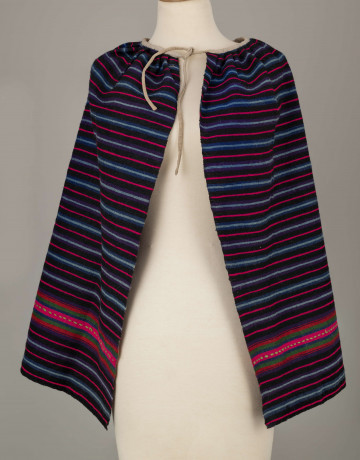
Skirt `burka`
1910
National Museum in Lublin
Part of the collection: Folk craft of the Lublin Region (19th/20th c.)
The skirt made of linen-wool fabric, for a festive costume, sewn on a sewing machine by Helena Skwarek, comes from the village of Kije, in the Łuków region. It was made before the First World War. It is long (76 cm), reaching almost to her ankles. It is the so-called skirt with a tail, maroon, with three black tapes sewn on at the bottom. It was a very popular and commonly-worn type of women's clothing in almost the entire Lublin region. They were made of trapezoidal wedges, and there could be 4, 6 or 8 of them. They had a slightly longer, more crinkled back at the waist, hence their name. The front was plain and had a hidden pocket on the side, and a slit on the other side fastened with a single hook. This part was covered by an apron, which is why it was not creased at the waist and decorative ribbons were not placed there, because they were not visible; it saved fabric and haberdashery. The skirt was reinforced on the inside with a strip of checked fabric to prevent it from fraying. This type of skirt originated in urban fashion and can be assumed to have heralded the changes that occurred in the way rural women dressed in the inter-war period. In the early days, they were worn mainly by young women who had more frequent contact with the city, and not wanting to stand out, tried to keep up with the prevailing fashion there.
Author / creator
Dimensions
cały obiekt: height: 300 cm, width: 76 cm
Object type
skirt
Technique
machine sewing
Material
flax, band
Creation time / dating
Creation / finding place
Owner
The National Museum in Lublin
Identification number
Location / status

1910
National Museum in Lublin

1930
National Museum in Lublin

1919 — 1939
National Museum in Lublin
DISCOVER this TOPIC
Castle Museum in Łańcut
DISCOVER this PATH
Educational path